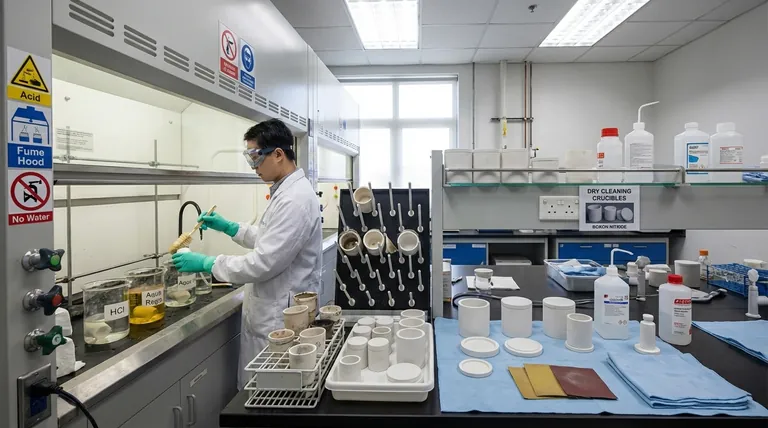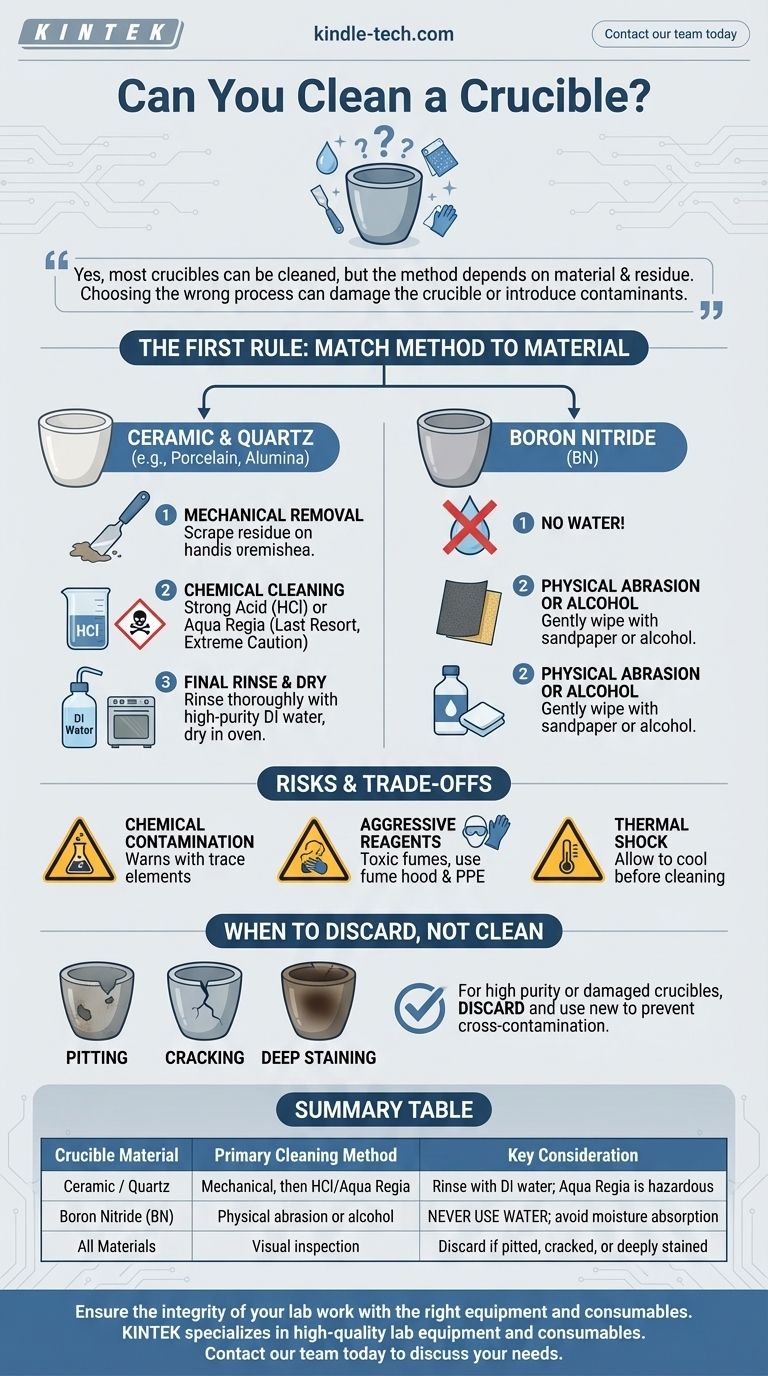Yes, most crucibles can be cleaned, but the correct method is entirely dependent on the crucible's material and the nature of the residue you need to remove. Using the wrong cleaning process can damage the crucible, introduce new contaminants, or fail to remove the original substance, compromising your future work.
The central challenge of cleaning a crucible is not the act of cleaning itself, but the selection of a method that is both effective for the residue and safe for the crucible's material. A universal cleaning solution does not exist; each material has its own specific requirements and limitations.

The First Rule: Match Method to Material
A crucible is a specialized tool, and its material is chosen for specific thermal and chemical properties. Your cleaning strategy must respect these properties to ensure the crucible's integrity for reuse.
Cleaning Ceramic and Quartz Crucibles
For common ceramic crucibles, such as those made of porcelain or alumina, a multi-step approach is often effective. These materials are generally very chemically resistant.
First, attempt mechanical removal by carefully scraping out as much residue as possible.
If residue remains, move to chemical cleaning. A strong acid like hydrochloric acid (HCl, ≥25 wt%) can dissolve many metallic and inorganic salts.
For extremely stubborn inorganic residues, a mixture of hydrochloric acid and nitric acid (HCl + HNO₃ in a 1:1 ratio), known as aqua regia, can be used. This is a last resort due to its extreme corrosivity.
Cleaning Boron Nitride (BN) Crucibles
Boron nitride is fundamentally different from traditional ceramics and requires a non-aqueous cleaning method.
BN is highly susceptible to moisture absorption, which can cause it to degrade and swell. Never wash a BN crucible with water.
The recommended method is physical abrasion. Gently wipe the interior with fine-grit sandpaper to remove the residue.
Alternatively, for lighter residues, scrubbing the crucible with alcohol and allowing it to dry completely can be effective.
Understanding the Trade-offs and Safety Risks
Aggressive cleaning saves a crucible but can introduce new variables into your experiments. You must be aware of the potential consequences.
The Risk of Chemical Contamination
Cleaning agents can leave their own trace residues. For example, using HCl can introduce chloride ions, which may interfere with subsequent chemical analyses.
Always perform a final, thorough rinse with high-purity deionized (DI) water for any crucible that can tolerate it (i.e., not Boron Nitride). Afterward, dry it completely in an oven to remove all moisture.
The Dangers of Aggressive Reagents
Mixtures like aqua regia are exceptionally hazardous. They produce toxic and corrosive fumes and must only be handled inside a certified fume hood while wearing appropriate personal protective equipment (PPE), including acid-resistant gloves, a lab coat, and safety goggles.
Thermal shock is another risk. Plunging a hot crucible into a cool cleaning solution can cause it to crack or shatter. Always allow the crucible to cool to room temperature before attempting to clean it.
When to Discard, Not Clean
For high-purity applications, trace element analysis, or when dealing with difficult-to-remove contaminants, the most reliable choice is to use a new crucible.
If a crucible shows any signs of pitting, cracking, or deep staining, it should be discarded. These surface imperfections can trap materials and are nearly impossible to clean, guaranteeing cross-contamination.
Making the Right Choice for Your Goal
Base your decision on the material of your crucible and the required purity of your next experiment.
- If your primary focus is removing tough inorganic residue from a porcelain or alumina crucible: Start with mechanical scraping, then escalate to HCl, using an aqua regia mixture only as a final resort under strict safety protocols.
- If your primary focus is cleaning a moisture-sensitive Boron Nitride crucible: Avoid all aqueous solutions. Use physical abrasion with sandpaper or wipe it down with alcohol.
- If your primary focus is ensuring the absolute highest purity for a sensitive analysis: Discard the used crucible and start with a new one to eliminate any risk of cross-contamination.
Ultimately, the integrity of your results is more valuable than the cost of a single crucible.
Summary Table:
| Crucible Material | Primary Cleaning Method | Key Consideration |
|---|---|---|
| Ceramic / Quartz | Mechanical scraping, then HCl or Aqua Regia | Rinse thoroughly with DI water; Aqua Regia is hazardous |
| Boron Nitride (BN) | Physical abrasion (sandpaper) or alcohol wipe | Never use water; avoid moisture absorption |
| All Materials | Visual inspection for damage | Discard if pitted, cracked, or deeply stained |
Ensure the integrity of your lab work with the right equipment and consumables.
Proper crucible maintenance is just one part of achieving reliable results. KINTEK specializes in providing high-quality lab equipment and consumables, including a full range of crucibles designed for specific applications. Our experts can help you select the right tools to maximize efficiency and prevent contamination.
Contact our team today to discuss your laboratory needs and discover how KINTEK's solutions can support your research and analysis goals.
Visual Guide

Related Products
- Boron Nitride (BN) Crucible for Phosphorous Powder Sintered
- Arc-Shaped Alumina Ceramic Crucible High Temperature Resistant for Engineering Advanced Fine Ceramics
- Engineering Advanced Fine Ceramics Alumina Al2O3 Crucible With Lid Cylindrical Laboratory Crucible
- Electron Beam Evaporation Coating Conductive Boron Nitride Crucible BN Crucible
- Engineering Advanced Fine Ceramics Alumina Crucibles (Al2O3) for Thermal Analysis TGA DTA
People Also Ask
- What is a crucible material for a furnace? A Guide to Choosing the Right High-Temperature Container
- What not to do with a crucible? Avoid These Common Mistakes to Ensure Safety and Longevity
- What is the proper way to use a crucible? Master Safe Handling and Precise Temperature Control
- What is the principle of quenching effect? Harnessing Molecular Interactions to Control Fluorescence
- What is the impact factor of powder metallurgy progress? A 2022 Analysis & Context



















